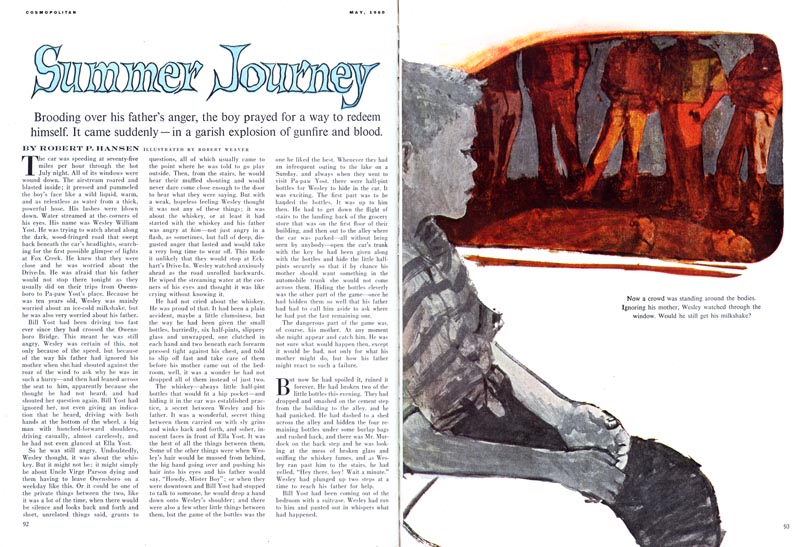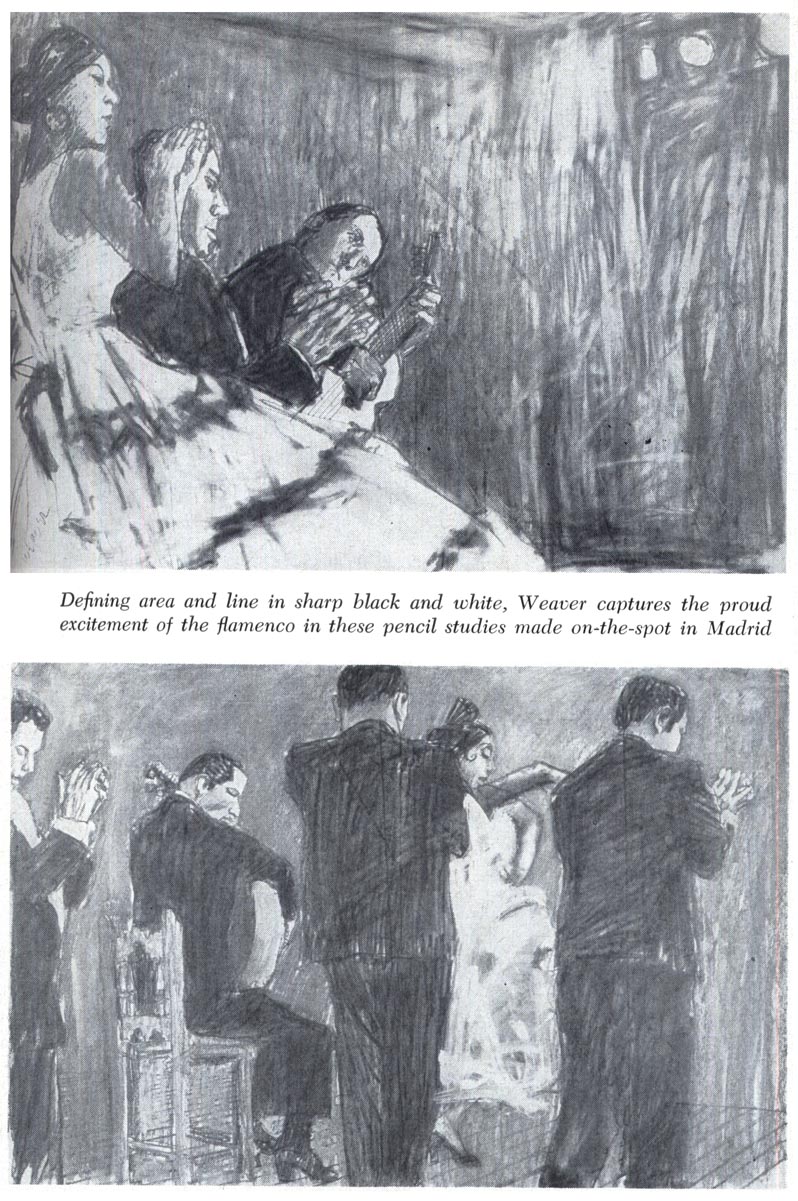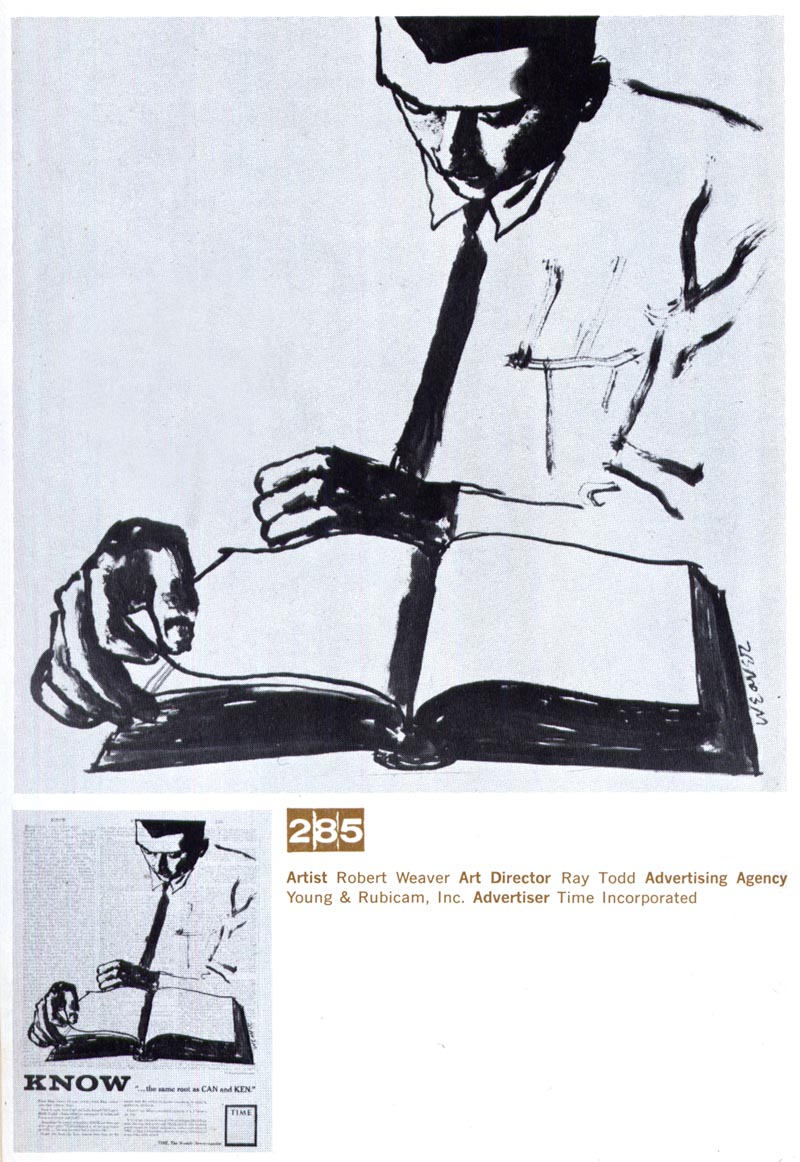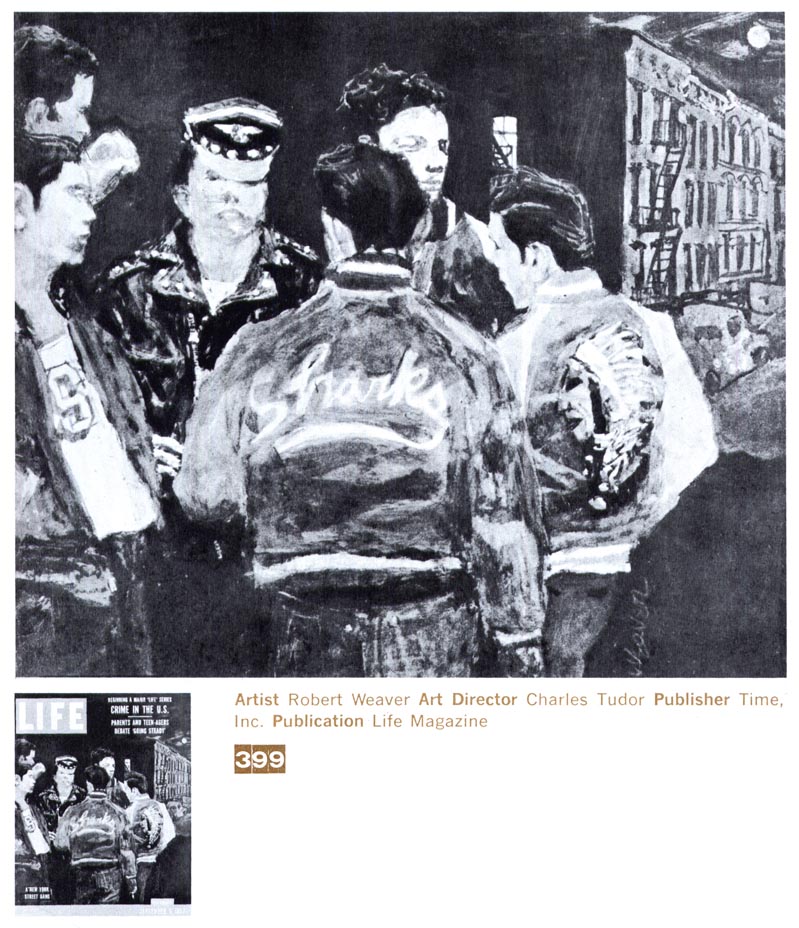For those who are at this point incensed, I again encourage you try to keep an open mind and see where this week takes us.
Personally, there's very little about Weaver's artwork that appeals to me. But there's a lot in his philosophy and advocacy of the merit of illustration that I find extremely compelling, and its his words that have made me see his work in a new light.

In his 1959 interview in American Artist magazine, Weaver said, "If as an illustrator I say what is wrong with contemporary 'serious' painting, it is because I see no reason why an illustrator should not see himself as a serious contemporary painter."
"The artist should not merely reflect; in an atomic era he should be the reactor."

Speaking to the then popular trend in fine art toward abstract expressionism, Weaver chastised the 'serious' art world with this powerful criticism:
"On the simplest level it is an incredible oversight on the part of the artist that he neglects to use his eyes. A true avant-garde might today proclaim the return of subject matter!"
"In my own teaching I am trying to remedy this deficiency by ordering students out onto the streets with sketchpads. Once the initial shock of life wears off the student can begin to discover the magnitude of the world."

A laudable attitude - and one that even the most conservative-minded traditionalist illustrator would surely agree with. But for those content to maintain the status quo, Weaver qualified his statement:
"But just as he cannot afford to ignore the world he cannot afford to turn his back on the good things in our modern painting."

"While there is the obvious omission of life in our contemporary art, there are far graver deficiencies in what little conservative painting of merit is still being attempted. we cannot go back or retrench, as some would urge. Art, as life, evolves. If we think we can disguise the fact that a new generation is coming into being that rejects what we think is important by calling it 'the beat generation' we are kidding ourselves."

"Conservatism may be sound policy in fiscal matters, but the artist who ignores his time does so at great peril to his usefulness."
* My Robert Weaver Flickr set.
I suspect Weaver would be rather surprised at where illustration and fine arts are today,in spite of his intellectual approach to how illustrators should think and react to the world. Both the illustration and the fine art world today seems well intrenched in "old school" traditional fundamentals of accurate drawing and rendering three-demential sculptural form, to reflect reality. Academic atelier schools have become quite popular. Weaver didn't focus on those aspects, but N.C. Wyeth certainly did. Weaver reflected reality much like the "Ashcan School" that became popular soon after the turn of the 20th Century. Robert Henri, George Bellows, John Sloan and others painted every day life in New York City.. backstreets, alleys and bars were often depicted with all their warts and bruises. Their paintings were unvarnished reality, choosing gritty and even seedy subject matter. This is where Weaver is most comfortable it seems. Obviously, elegance, glamour and traditional beauty was not Weaver's interest. In that respect he reflected Norman Rockwell's similar disinterest in portraying a high society life style.
ReplyDeleteSo, Weaver sent his students out on the streets to draw the everyday world, which is a fine idea, but why don't we see it in illustrations today.. or in fine art for that matter? I mean, it seems like we have gone back to fantasy subjects, in many ways. Back to what N.C. Wyeth loved doing for those wonderful classic novels. Reality in fine arts today is the feel good reality.. mother and daughter on the beach, pretty woman reading in the rose garden, secluded picturesque harbors, sweeping Tuscany vineyards and charming European country villages.
So, what happened to Weaver's deep philosophical direction for illustration in his day and for the future? Why didn't it stick, and progress? Every quote I read from Weaver, brings up another question. I hope one of his students reads this blog, and can give us his or her insight.
Tom Watson
I always stick my neck out on the first commen!! On the art, Leif, I like the bold B&W of the guy with necktie.
ReplyDeleteAmong other things.... where I think Weaver is wrong.....he seems to have a disregard for history and the passage of time. Isn't it odd after his announcement in the late 50's 'our kind of illustration is dead', I and other illustrators of my time worked another 30 years in the biz not knowing we were obsolete. Actually throughout my blog I point out, over and over, change is the only constant, and even though we could witness the demise of the printed media as we worked, illustration kept going.
After firng off my anti-Weaver letter last week, I turned on a TV documentary by accident....a 'history' of Coca Cola from back in the teens. The early experiments with the secret formula, the evolution of the wasp waist bottle, the advent of competition, later experiments with the taste, etc. Even the beginning of the effective ad campaign....including the famous Sunblom Santa Claus. During those years I grew up admiring J.C.Leyendecker, Norman Rockwell, and a host of other talented illustrators of the 30's and 40's. Then, post war and years later, I began my ad career, gradually gaining knowledge and abilities as I went. Weaver seems to belittle and condense all that....and the passage and progress of the great illustrative talents in the mid-century east. Weaver somehow assigns that time and those careers into an irrelevent blink.
This is long and garrulous....but before leaving....I had a calendar of NC Wyeth's great 'Treasure Island' illustrations in oils that I really wanted viewers to see. Leif added some of his later work, including 'The Yearling' illustrations. Wyeth was not typical of most illustrators.... and ended on a mediocre note. He was not a starting, nor an ending, milestone in illustrative history.
Right on, Tom!
ReplyDeleteLeif, What is it that you find unappealing in Weaver's work? I find it quite beautiful and compelling. I have a few children's books he illustrated, copies of magazines with astute observations of color and light, well drawn figures, original compositions that surprise, and a love of seeing.
ReplyDeleteLeif, there are so many colliding factors involved with Weaver, many people find it difficult to have a consistent reaction to him. On the one hand, he was passionate, intellectually committed and an innovative artist. On the other hand, he could be an arrogant jerk and a mean drunk, gratuitously nasty to peers and admirers (such as Coby Whitmore and Joe Bowler).
ReplyDeleteBesides, in my view if you want extra credit for the intellectual content of your artwork, you'd better be pretty darn smart. I think a lot of the "socially conscious" themes he trumpeted were pretty superficial, while many of his more traditional peers, such as Stanley Meltzoff or Leonard Starr, were true intellectuals-- far more erudite, better read, far smarter.
Putting aside all of the collateral issues (if that's possible with Weaver) the best assessment of the origins and quality of Weaver's pictures that I've ever heard came from your friend Murray Tinkelman, who traces Weaver back to Ben Shahn. If you can persuade Murray to speak up, I think your readers would be enriched by his insights.
This comment has been removed by the author.
ReplyDeleteI think it is a sad state of affairs when we start to criticize the dead. Especially when we speak ill of people whom we don't know. Making statements about one's intellect, and calling someone names who isn't here to defend themselves is really not a way to invite an intelligent debate.
ReplyDeleteMaybe we all need to be smarter.
Picasso was a womanizer, Caravaggio was accused of murder, Gaugin apparently was the person who cut off Van Gogh's ear, Schiele was jailed for obscenity and what is akin to child pornography. The list goes on, but does this pointing out of the deads' flaws move the discussion forward?
I think we are all biased by the things we cling to and the things we dislike. None of us can really have an objective point of view, or judge the motives or intelligence of another. How can one say that one person was better read than another? I don't think it is possible to know the mind or personal history of another person without having lived with them, being married to them, or being very close.
Bill Koeb wrote: "I think it is a sad state of affairs when we start to criticize the dead."
ReplyDeleteBill, I don't agree with that and I suspect you don't either. After all, you'd have no problem criticizing Hitler (who, last time I checked, was dead).
I suspect what you really meant is that an artist's personal life should be irrelevant to his or her work, or that we should be very careful to get our facts straight if we are going to speak critically (or admiringly) about historical figures. Those are both perfectly legitimate views. My own view is that such facts remain an important part of understanding the clash of styles and generations we are discussing, as long as we exercise the kind of care and diligence that any responsible historian would.
Here are some examples of what I was talking about: it is well established that Weaver publicly derided Whitmore and Bowler-- two illustrators who enjoyed and welcomed his new style-- as "candy box artists" and said at a public meeting that it was his ambition to put them "out of business." (Apparently, no one ever shared your point with him that it isn't nice to speak ill of people.) When a young Bernie Fuchs met Weaver at the Society of Illustrators and sought encouragement about becoming an illustrator, Weaver chewed him out in a loud voice, telling him that no self-respecting artist would want to be an illustrator, that it was a crappy profession and that he "hated it." Fuchs scampered away with his tail between his legs and was shook up for quite a while. (Fuchs told me that story himself).
If you want to understand how Weaver rattled the establishment, or how people reacted to the friction between generations, I'm not sure we can blind ourselves to the rich history of the time.
In fact, Weaver wouldn't want you to. He is the one who argued we shouldn't be content to accept the airbrushed, idealized versions of the facts but should go out to look at the harsh realities of the real world. You may want to grant him an exemption from his own standards, but I don't think it is honoring his tradition to do so.
Look, I love a lot of Weaver's work. It is interesting and innovative and an he was an important force in illustration's perception of its own role. I'm just saying that for me, it is not irrelevant that he was sometimes an "arrogant jerk."
Interesting discussion on Weaver, and much of what is being said reinforces my gut feeling that as unique and dogmatic Weaver may have been in his approach to illustration, he was a 'flash in the pan', and his direction never really took root and grew very far. If we draw and paint for ourselves and/or our piers alone, we may be simply appealing to those who appreciate our point of view, but illustration has to communicate to the general public that doesn't really understand or care about the philosophical nuances that Weaver was quoted in the AA article. The public just knows if it appeals to them or not. I think it was a very small segment of the public that would consider Weaver's illustrations significant or memorable. But, a much larger segment did consider Coby Whitmore or Joe Bowler's illustrations not only significant and memorable, but quite appealing. My wife, who is not an artist nor an illustration buff, specifically recalled the illustrations of Coby Whitmore, Joe Bowler, Al Parker, Bernie Fuchs and a few others, from the 50's and 60's magazine stories when she was in her teens and 20s'. Friends and family have also have made similar remarks.
ReplyDeleteSo, was the public really looking for a wave of innovative "progressive" illustration approaches to seduce them into reading the magazines, or was it driven more by the Art/Creative Directors and illustrators like Weaver.. illustrators that hated illustration as it was? The big fear as an art student in the late 50s', was to not keep up with the illustration trends, because that was what drove the movement. But, did we really need to do that to find a place in illustration? Did Norman Rockwell vanish, or did Charlie Allen vanish after the innovative 60's? Nope, and there were plenty of other very busy illustrators in S.F. and Chicago where I worked, and some I knew in N.Y., that had solid traditional drawing and painting skills.. and we all found challenging quality assignments, long after Weaver faded out of the picture. Even Bernie Fuchs returned to a literal traditional approach in oils on canvas, which remained very popular until his death. Real quality should never, and in my opinion, will never go out of favor, and will always be appreciated by the masses!
Tom Watson
"Right on, Tom!" - I can only echo Charlie Allen's remark.
ReplyDeleteTime will tell. Time is the ultimate evaluator. Evaluating things transient, ephemeral; against things that last for ever and ever....
Wow, love the passion in these comments. With no previous knowledge of Weaver my observations come from his aesthetic choices and what he himself has stated. I agree with Tom that Weaver seems like a product of his times.
ReplyDeleteThe times were uncertain with everything being questioned and a redefining of human consciousness explored.
I sense a great frustration mixed with fear and inadequacy which leads to bombastic self righteousness as a mask.
When everything is in flux it's hard to be relevant unless you make an empirical statement that you are being relevant.
Tom-- excellent points. And since you raised Al Parker, I would suggest that he was a more effective revolutionary than Weaver, if you look at where the field of illustration was when Parker started and what he was doing by the time he finished. I think he moved the ball farther than Weaver-- he just wasn't as noisy (and, in Joel's well chosen words, "self righteous") about it.
ReplyDeleteAll of this may sound like I am trying to beat up on Weaver, but I am really not. I have a large file of his tearsheets that I enjoy reviewing, and I appreciate his passion. I just think he has a mixed record, and it would be a mistake to let him dictate his own place in history just because his decibel level was higher than that of other, equally talented illustrators.
I don't know if I can state this in a way that will make you understand, or in a way that will make you believe it, but as far as I know from talking to a lot of illustrators as to who influenced them, Robert Weaver ranks way up at the top. He influenced illustrators in the 50's, 60's, 70's, 80's, on and on and continues to have an impact on how people approach illustration.
ReplyDeleteAs for the comment on speaking ill of the dead, I think that I elaborated on what I meant by this in my post and think that comparing speaking ill of Hitler to speaking of a dead artist's motives or education is the most obvious and ridiculous comparison I have read and really too inflammatory to speak to.
I have known a lot of illustrators in my life. Some really nice, some completely horrible. When I let my personal feelings about them cloud my judgement about their work (and I have at times) I am doing myself and them a disservice.
Anyhow, I enjoy seeing the work. I don't like or agree with all of the comments, but everyone has there own experience of things, and I am not in a position to tell someone that they are wrong.
PS I don't want to speak ill of Hitler either, but he was a boring, crappy artist.
Just a thought.
I think Oskar Koskoschka actually mused over what might have happened if Hitler had been accepted to art school and he hadn't.
Some quick and belated remarks:
ReplyDelete- any art historian would question the idea that the artist's personal life was irrelevant to studying the work. It is certainly worth taking into account. It remains to be seen, AFTER doing so, whether it turns out to be relevant or not. You have to make the case.
- Tom wrote, "I think it was a very small segment of the public that would consider Weaver's illustrations significant or memorable." - I would disagree, since so many periodicals used RW repeatedly throughout the decade. Esquire even used him to promote the magazine in advertisements in other publications. The copy of this ad says how au courant they are with the latest art and fashion BECAUSE they feature RW.
- I have personally asked Milton Glaser about Weaver's influence, and he said RW was seminal for Glaser's generation, one of the illustrators they were inspired by whn they began Pushpin.
Jaleen, I agree that at the time Weaver had a bright spotlight on him, because he definitely was innovative, pushed the envelope further than most illustrators and was winning his share of awards. Some of his peers loved what he was doing, some were not that excited and some thought his stuff was crude and heavy handed, but as far as I could tell, the general public wasn't jumping up and down because some guy by the name of Robert Weaver was one of the pioneers of the 60s' visual revolution. I never saw that reaction nor did my illustrator friends, and I was working as an illustrator at that time. The fact that some art directors found him to be dipped in gold and eager to use him, probably had more to do with trying to keep up with the frenzy of an even newer 'new wave' look to their magazine or product, which soon fizzled out anyway, along with much of the magazine industry. I don't think any illustrator or art director could have saved that from happening, but Weaver was merely a part of the mid century history of the decline in illustration. Dare I say that I'm confident that far more of the public was and still are, far more aware of N.C.Wyeth, Norman Rockwell or J.C. Lyendecker than Robert Weaver.
ReplyDeleteTom Watson